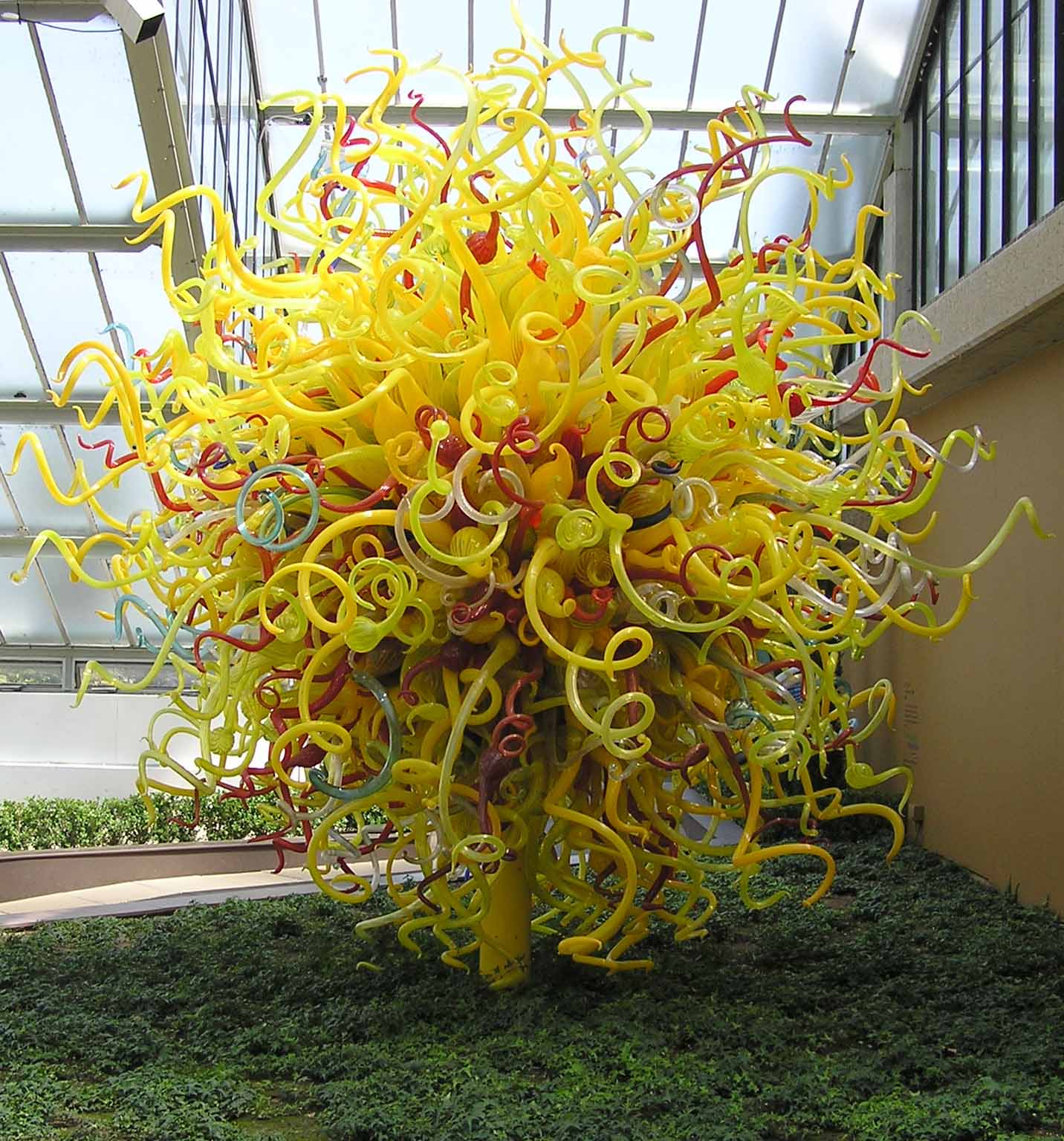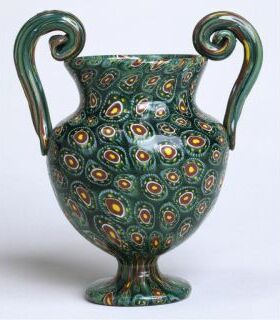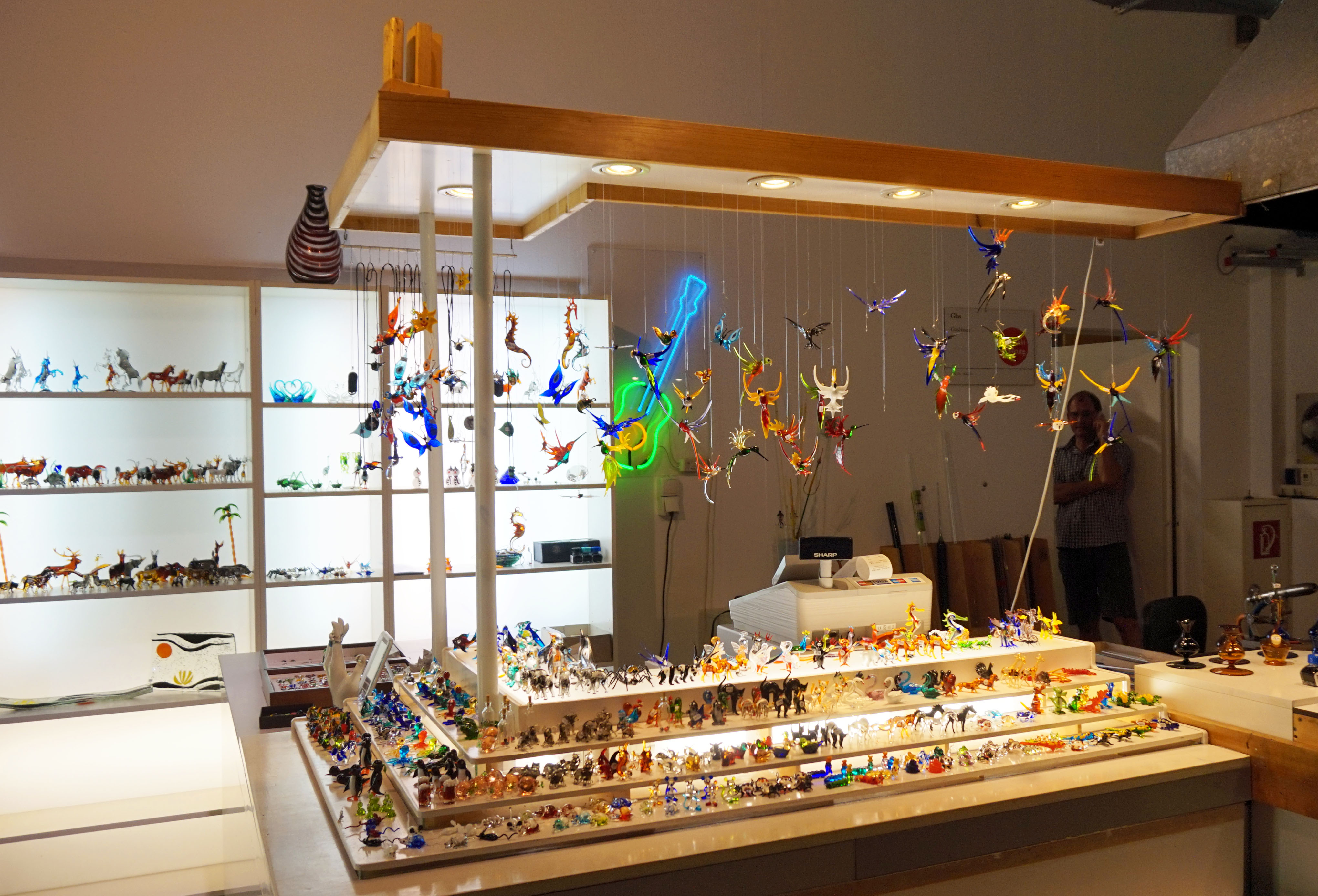 |
Caneworking
In glassblowing, cane refers to rods of glass with color; these rods can be simple, containing a single color, or they can be complex and contain strands of one or several colors in pattern. Caneworking refers to the process of making cane, and also to the use of pieces of cane, lengthwise, in the blowing process to add intricate, often spiral, patterns and stripes to vessels or other blown glass objects. Cane is also used to make murrine (singular ''murrina'', sometimes called mosaic glass), thin discs cut from the cane in cross-section that are also added to blown or hot-worked objects. A particular form of murrine glasswork is millefiori ("thousand flowers"), in which many murrine with a flower-like or star-shaped cross-section are included in a blown glass piece. Caneworking is an ancient technique, first invented in southern Italy in the second half of the third century BC, and elaborately developed centuries later on the Italian island of Murano. Making cane There are sev ... [...More Info...] [...Related Items...] OR: [Wikipedia] [Google] [Baidu] |
|
David Patchen
David Scott Patchen (born ) is an American glass artist who uses the techniques of cane and murrine in an American style. Early life and education David Scott Patchen was born in in New Rochelle, New York. He is primarily self-taught since 2001. Informal education included visits to the studio of Afro Celotto, maestro and former assistant to Lino Tagliapietra in Murano, Italy, and an artistic merit scholarship to the Pilchuck Glass School. Work and career Early in his career, Patchen assisted several artists including Afro Celotto and Marvin Lipofsky in creating their work. Patchen's work is internationally known primarily for a combination of intricately patterned and vibrant color combinations in large scale blown glass. Patchen's series include forms titled "Resistenza", "Foglio", "Parabola", "Allegro", "Bloom", "Piscine", "Ellipse" and "Spheres" which are created in murrine and/or cane. He has collaborated on sculptures with glass artists Mark Leputa in 2017, Rob ... [...More Info...] [...Related Items...] OR: [Wikipedia] [Google] [Baidu] |
|
|
Murrine
Murrine (singular: murrina) are colored patterns or images made in a glass cane that are revealed when the cane is cut into thin cross-sections. Murrine can be made in infinite designs from simple circular or square patterns to complex detailed designs to even portraits of people. One familiar style is the flower or star shape which, when used together in large numbers from a number of different canes, is called millefiori. Murrine production first appeared in the Middle East more than 4,000 years ago and was revived by Venetian glassmakers on Murano in the early 16th century.Carl I. Gable, ''Murano Magic: Complete Guide to Venetian Glass, its History and Artists'' (Schiffer, 2004), p. 37. . Once murrine have been made, they can be incorporated into a glass vessel or sculpture in several ways. A number of murrine may be scattered, more or less randomly, on a marver (steel table) and then picked up on the surface of a partially-blown glass bubble. Further blowing, heating, an ... [...More Info...] [...Related Items...] OR: [Wikipedia] [Google] [Baidu] |
|
 |
Studio Glass
Studio glass is the modern use of glass as an artistic medium to produce sculptures or three-dimensional work of art, artworks in the fine arts. The glass objects created are typically intended to make a sculptural or decorative statement, rather than fulfill functions (other than perhaps as vases) such as tableware. Though usage varies, the term is properly restricted to glass made as art in small workshops, typically with the personal involvement of the artist who designed the piece. This is in contrast to art glass, made by craftsmen in factories, and glass art, covering the whole range of glass with artistic interest made throughout history. Both art glass and studio glass originate in the 19th century, and the terms compare with studio pottery and art pottery, but in glass the term "studio glass" is mostly used for work made in the period beginning in the 1960s with a major revival in interest in artistic glassmaking. Pieces are often unique, or made in a small limited ed ... [...More Info...] [...Related Items...] OR: [Wikipedia] [Google] [Baidu] |
|
Glossary Of Glass Art Terms
A glossary of terms used in glass art *Abrasion – the technique of grinding shallow decoration with a wheel or some other device. The decorated areas are left unpolished. *Ale glass – a type of English drinking glass for ale or beer. Ale glasses, first made in the 17th century, have a tall and conical cup, a stem, and a foot. They may be enameled, engraved, or gilded with representations of hops or barley. *At-the-fire – the process of reheating a blown glass object at the glory hole during manufacture, to permit further inflation, manipulation with tools, or fire polishing. * Annealing – The process of slowly cooling a blown or cast object to prevent the stresses of rapid cooling from cracking or damaging the object. *Battledore – a glassworker’s tool in the form of a square wooden paddle with a handle. Battledores are used to smooth the bottoms of vessels and other objects. *Blank – any cooled glass object that requires further forming or decoration to be finished. ... [...More Info...] [...Related Items...] OR: [Wikipedia] [Google] [Baidu] |
|
 |
Tweezers
Tweezers are small hand tools used for grasping objects too small to be easily handled with the human fingers. Tweezers are thumb-driven forceps most likely derived from tongs used to grab or hold hot objects since the dawn of recorded history. In a scientific or medical context, they are normally referred to as just "forceps", a name that is used together with other grasping surgical instruments that resemble pliers, pincer (tool), pincers and scissors-like clamp (tool), clamps. Tweezers make use of two third-class levers connected at one fixed end (the wikt:fulcrum, fulcrum point of each lever), with the pincers at the others. When used, they are commonly held with one hand in a pen grip between the thumb and index finger (sometimes also the middle finger), with the top end resting on the first dorsal interossei of the hand, dorsal interosseous muscle at the webspace between the thumb and index finger. Spring tension holds the grasping ends apart until finger pressure is applie ... [...More Info...] [...Related Items...] OR: [Wikipedia] [Google] [Baidu] |
 |
Glass Production
Glass production involves two main methods – the float glass process that produces sheet glass, and glassblowing that produces bottles and other containers. It has been done in a variety of ways during the history of glass. Glass container production Broadly, modern glass container factories are three-part operations: the "batch house", the "hot end", and the "cold end". The batch house handles the raw materials; the hot end handles the manufacture proper—the forehearth, forming machines, and annealing ovens; and the cold end handles the product-inspection and packaging equipment. Batch processing system (batch house) Batch processing is one of the initial steps of the glass-making process. The batch house simply houses the raw materials in large silos (fed by truck or railcar), and holds anywhere from 1–5 days of material. Some batch systems include material processing such as raw material screening/sieve, drying, or pre-heating (i.e. cullet). Whether automated or ... [...More Info...] [...Related Items...] OR: [Wikipedia] [Google] [Baidu] |
 |
Glass Art
Glass art refers to individual works of art that are substantially or wholly made of glass. It ranges in size from monumental works and installation pieces to wall hangings and windows, to works of art made in studios and factories, including glass jewelry and tableware. As a decorative and functional medium, glass was extensively developed in Ancient Egypt, Egypt and Assyria. Glassblowing was perhaps invented in the 1st century BC, and featured heavily in Roman glass, which was highly developed with forms such as the cage cup for a luxury market. Islamic glass was the most sophisticated of the early Middle Ages. Then the builders of the great Norman architecture, Norman and Gothic architecture, Gothic cathedrals of Europe took the art of glass to new heights with the use of stained glass windows as a major architectural and decorative element. Glass from Murano, in the Venetian Lagoon, (also known as Venetian glass) is the result of hundreds of years of refinement and inventi ... [...More Info...] [...Related Items...] OR: [Wikipedia] [Google] [Baidu] |
 |
Millefiori
Millefiori () is a glasswork technique which produces distinctive decorative patterns on glassware. The term millefiori is a combination of the Italian words "mille" (thousand) and "fiori" (flowers). Apsley Pellatt in his book ''Curiosities of Glass Making'' was the first to use the term "millefiori", which appeared in the ''Oxford English Dictionary The ''Oxford English Dictionary'' (''OED'') is the principal historical dictionary of the English language, published by Oxford University Press (OUP), a University of Oxford publishing house. The dictionary, which published its first editio ...'' in 1849; prior to that, the beads were called mosaic beads. While the use of this technique long precedes the term "millefiori", it is now most frequently associated with Venetian glassware. Since the late 1980s, the millefiori technique has been applied to polymer clay and other materials. As the polymer clay is quite pliable and does not need to be heated and reheated to fuse it, ... [...More Info...] [...Related Items...] OR: [Wikipedia] [Google] [Baidu] |
|
Example Of Reticello - David Patchen 3692
Example may refer to: * ''exempli gratia'' (e.g.), usually read out in English as "for example" * .example, reserved as a domain name that may not be installed as a top-level domain of the Internet ** example.com, example.net, example.org, and example.edu: second-level domain names reserved for use in documentation as examples * HMS ''Example'' (P165), an Archer-class patrol and training vessel of the Royal Navy Arts * ''The Example'', a 1634 play by James Shirley * ''The Example'' (comics), a 2009 graphic novel by Tom Taylor and Colin Wilson * Example (musician), the British dance musician Elliot John Gleave (born 1982) * ''Example'' (album), a 1995 album by American rock band For Squirrels See also * Exemplar (other), a prototype or model which others can use to understand a topic better * Exemplum, medieval collections of short stories to be told in sermons * Eixample The Eixample (, ) is a district of Barcelona between the old city (Ciutat Vella) a ... [...More Info...] [...Related Items...] OR: [Wikipedia] [Google] [Baidu] |
|
 |
Flameworking
Lampworking is a type of glasswork in which a torch or lamp is used to melt the glass. Once in a molten state, the glass is formed by blowing and shaping with tools and hand movements. It is also known as flameworking or torchworking, as the modern practice no longer uses oil-fueled lamps. Although lack of a precise definition for lampworking makes it difficult to determine when this technique was first developed, the earliest verifiable lampworked glass is probably a collection of beads thought to date to the fifth century BCE. Lampworking became widely practiced in Murano, Italy in the 14th century. As early as the 17th century, itinerant glassworkers demonstrated lampworking to the public. In the mid-19th century lampwork technique was extended to the production of paperweights, primarily in France, where it became a popular art form, still collected today. Lampworking differs from glassblowing in that glassblowing uses a furnace as the primary heat source, although torches ... [...More Info...] [...Related Items...] OR: [Wikipedia] [Google] [Baidu] |